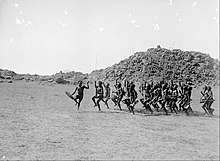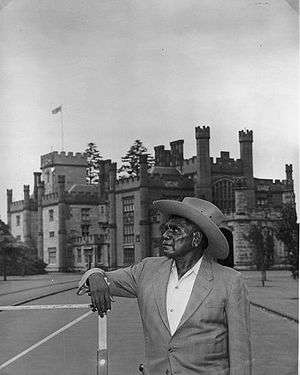Arrernte people


The Arrernte /ərʌndə/ people, sometimes referred to as the Aranda, Arunta, or Arrarnta are an Aboriginal Australian people who live in the Arrernte lands, at Mparntwe[1][2] (Alice Springs)[lower-alpha 1] and surrounding areas of the Central Australia region of the Northern Territory. Some Aranda live in other areas far from their homeland, including the major Australian cities and overseas.
Aranda mythology and spirituality focuses on the landscape and the Dreamtime. Altjira is the creator being of the Inapertwa that became all living creatures. Tjurunga are objects of religious significance.
The Arrernte Council is the representative and administrative body for the Aranda Lands and is part of the Central Land Council.
Tourism is important to the economy of Alice Springs and surrounding communities.[4][lower-alpha 2]
Arrernte languages and dialects
The ancestors of the Aranda all spoke one or more of the Arrernte group of languages/dialects (see below). "Aranda" is a simplified, Australian English approximation of the traditional pronunciation of the name of Arrernte [ˈarəɳ͡ɖa ].[6]
Aranda people speak the following Arrernte dialects/languages:
- Alyawarra (Alyawarr)
- Anmatjirra (Anmatyerr)
- Antekerrepenhe
- Ayerrerenge
- Eastern dialect,Ikngerripenhe
- Central Aranda, or Mparntwe Arrernte.
- Lower Aranda, known as Alenjerntarpe.. This dialect was spoken by the people around the Finke River area, and is now extinct. The last speaker was Brownie Doolan, from whom Gavan Breen managed to write up a dictionary of roughly 1000 words.[7]
- Southern Aranda|Southern Aranda dialect, Pertame.
- Western Aranda, Tyuretye Arrernte,/Arrernte Alturlerenj.[8][lower-alpha 3][lower-alpha 4]
The Aranda had a highly developed sign language.[11]
Country
The Arrernte's traditional lands, according to Norman Tindale's estimate, encompassed some 47,000 square miles (120,000 km2).[12] Of their overall territory he writes that they were:-
At Mount Gosse, Mount Zeil, and Mount Heughlin; on the Finke River to Idracowra, Blood Creek, Macumba, Mount Dare, and Andado, and some distance east into the sandhills of the Arunta (Simpson) Desert; northeast to Intea on the lower Hale River, thence north to Ilbala on Plenty River; west to Inilja and Hart Range, Mount Swan, Gillen Creek, Connor Well, and Narwietooma; in Central MacDonnell, James, and Ooraminna Ranges.[12]
Sub-divisions
The name Aranda refers to the following distinct groups (or "mobs"):
- Central Aranda, from the township of Alice Springs only.
- Eastern Aranda, from the Aranda lands east of Alice Springs.
- Western Aranda, from the Aranda lands west of Alice Springs, out to Mutitjulu and King's Canyon.
See also
- Spirituality & mythology
Notes
- ↑ Earlier the town was also referred to as Tjoritja, the word for the MacDonnell Ranges, and also frequently as Kapmanta (etymologically, kaputa(head) plus manta (thick), because it struck Arrernte visitor as so many packed corrugated roofs together ('head' as in househead/roof) ('In neuerer Zeit wird Alice Springs häufig Kapmanta genannt:kap ist eine Abkürzing von kaputa = Kopf und manta = dicht.) Kapmanta heißt wörtlich: dichter Kopf. Gemeint sind:dichte Dächer (Dach = des Hauses Kopf) weil hier die Eingeboreren zuerst mit Wellblech gedeckte Dächer gesehen haben'.[3]
- ↑ The Aranda way of life is presented through tour guides and storytellers speaking of the life, their artwork, their culture and language in a variety of different ways. Tours are run regularly to Hermannsburg and Wallace Rockhole, both of which are (Western) Aranda,[5] so as to learn more about the Aranda way of life, from their artwork to their culture and language.
- ↑ In Western Aranda lands the preferred spelling for their language is 'Arrarnta' or 'Aranda'.[9]
- ↑ 'The Arandic group whose culture Carl Strehlow documented in great detail identify themselves today as Western Aranda or Arrarnta. They call themselves sometimes Tyurretyerenye, meaning 'belonging to Tyurretye', and refer to their Arandic dialect as Western or Tyurretye Arrernte.' '[10]
Citations
- ↑ Brooks 1991.
- ↑ Short 2013, p. 196.
- ↑ Strehlow 1907, p. 42, n.7.
- ↑ Ryan, Deane & Cunningham 2008, pp. 286–288.
- ↑ AAA&CC.
- ↑ Turpin 2004.
- ↑ Kearney 2007.
- ↑ Dixon 2002, p. xxxix.
- ↑ Kenny 2013, p. xvii.
- ↑ Kenny 2013, p. 6.
- ↑ Kendon 1988, pp. 49–50.
- 1 2 Tindale 1974, pp. 220–221.
Sources
- "Aboriginal Art Culture and Tourism Australia". Aboriginal Australia Art & Culture Centre. Retrieved 23 March 2013.
- "AIATSIS map of Indigenous Australia". AIATSIS.
- Brooks, David (1991). A Town Like Mparntwe: A Guide to the Dreaming Tracks and Sites of Alice Springs. Jukurrpa Books. ISBN 978-1-864-65045-7.
- Dixon, R. M. W. (2002). Australian Languages: Their Nature and Development. Cambridge University Press. ISBN 978-0-521-47378-1.
- Kearney, Simon (20 September 2007). "Another language faces sunset in dead centre" (PDF). The Australian, Swarthmore College.
- Kendon, Adam (1988). Sign Languages of Aboriginal Australia: Cultural, Semiotic and Communicative Perspectives. Cambridge University Press. ISBN 978-0-521-36008-1.
- Kenny, Anna (2013). The Aranda's Pepa: An introduction to Carl Strehlow's Masterpiece Die Aranda- und Loritja-Stämme in Zentral-Australien (1907-1920). Australian National University. ISBN 978-1-921-53677-9. JSTOR j.ctt5hgz6k.10.
- Morton, John (2013). "'Less was hidden among these children': Géza Roheim, Anthropology and the Politics of Aboriginal Childhood". In Eickelkamp, Ute. Growing Up In Central Australia: New Anthropological Studies of Aboriginal Childhood and Adolescence. Berghahn Books. pp. 15–48. ISBN 978-1-782-38127-3.
- Ryan, Mark David; Deane, Michael; Cunningham, Stuart (2008). "Australian Indigenous Art: Local Dreamings, Global Consumption". In Anheier, Helmut K.; Isar, Yudhishthir Raj. Cultures and Globalization: The Cultural Economy. SAGE. pp. 284–291. ISBN 978-1-473-90357-9.
- Short, John Rennie (2013). Globalization, Modernity and the City. Routledge. ISBN 978-1-136-67151-7.
- Strehlow, C. (1907). Leonhardi, Moritz von, ed. Die Aranda- und Loritja-Stämme in Zentral-Australien: Part 1 Mythen, Sagen und Märchen des Aranda –Stammes (PDF). Joseph Baer & Co.
- Strehlow, C. (1908). Leonhardi, Moritz von, ed. Die Aranda- und Loritja-Stämme in Zentral-Australien: Part 2. Mythen, Sagen und Märchen des Loritja–Stämmes (PDF). Joseph Baer & Co.
- Strehlow, C. (1910). Leonhardi, Moritz von, ed. Die Aranda- und Loritja-Stämme in Zentral-Australien Part 3 (PDF). Joseph Baer & Co.
- Strehlow, C. (1913a). Die Aranda- und Loritja-Stämme in Zentral-Australien Part 4: Abteilung (PDF). Joseph Baer & Co.
- Strehlow, C. (1913b). Die Aranda- und Loritja-Stämme in Zentral-Australien.: Part 4. 1 Abteilung: Stammbaum Tafeln (PDF). Joseph Baer & Co.
- Strehlow, C. (1920). Die Aranda- und Loritja-Stämme in Zentral-Australien: Part 5 (PDF). Joseph Baer & Co.
- Tindale, Norman Barnett (1974). "Aranda (NT)". Aboriginal Tribes of Australia: Their Terrain, Environmental Controls, Distribution, Limits, and Proper Names. Australian National University.
- Turpin, Myfany (August 2004). "Have you ever wondered why Arrernte is spelt the way it is?". Central Land Council.
External links
| Wikimedia Commons has media related to Arrernte people. |